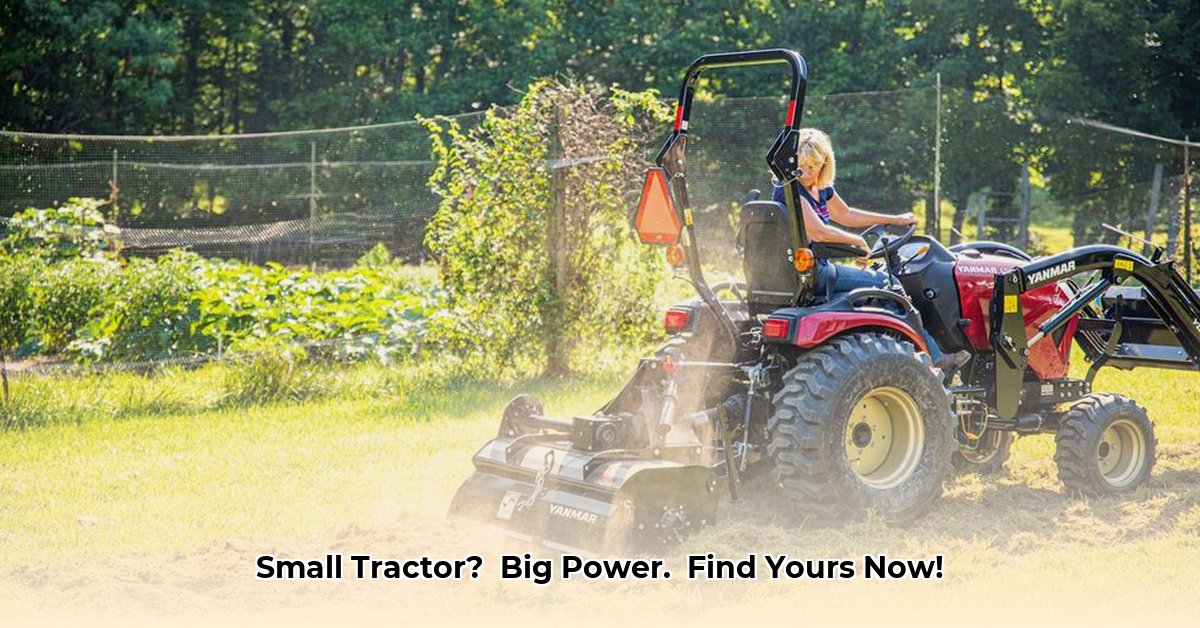
Choosing the right small tiller tractor can feel overwhelming. This guide simplifies the process, helping you select the perfect machine for your needs. We'll cover horsepower, tiller width, drive systems, safety features, and maintenance, empowering you to make an informed decision. For more information on New Holland tractors, check out this helpful resource.
Horsepower and Tiller Width: Finding the Right Balance
The size of your tiller must match your tractor's capabilities. Too small a tractor will struggle; too large a tiller will strain it. Think of it like this: you want a comfortable fit, not a forced one. A good starting point is to ensure your tractor's horsepower comfortably exceeds the tiller's requirements. Heavier soils (clay) require more powerful tractors and robust tillers than lighter soils (sandy loam). This ensures efficient tilling without overloading your equipment.
Drive Systems: Chain vs. Gear – What's Right for You?
Two main drive systems exist: chain and gear. Gear drives are generally more durable and efficient, offering smoother power transfer and longer lifespan, though they come at a higher price point. Chain drives, conversely, are more budget-friendly and easier to repair, but might require more frequent maintenance, including lubrication. The best choice depends on budget, frequency of use, and desired longevity.
| Drive System | Pros | Cons | Maintenance | Cost |
|---|---|---|---|---|
| Chain | Affordable, simpler repairs | Requires more frequent lubrication | Regular lubrication and chain adjustment | Lower |
| Gear | Durable, efficient, smooth operation | More expensive, repairs can be complex | Periodic inspection | Higher |
Tiller Rotation: Forward or Reverse?
Tiller rotation affects soil preparation and safety. Reverse rotation throws soil away from the operator, potentially reducing the risk of rock impacts. Forward rotation, conversely, pulls soil towards the tractor, which some users find creates better soil structure. The ideal choice depends on individual preferences and soil conditions. Consider the type of soil and the presence of existing plants or seeds, as forward rotation can be more disruptive.
Safety First: Shear Bolts and Slip Clutches
Protecting your investment (and yourself!) is paramount. Shear bolts and slip clutches are safety mechanisms that protect against damage from rocks or other obstructions. A shear bolt breaks under excessive stress, safeguarding the more expensive components. A slip clutch allows controlled slippage, preventing sudden stops and potential damage. Both offer protection; the choice depends on personal preference and risk tolerance.
Tine Count and RPM: Optimizing Tilling Performance
The number of tines (the rotating blades) and their rotational speed (RPM) significantly affect tilling effectiveness. More tines generally provide broader coverage, but increase the load on the tractor. Higher RPMs create finer soil tilth, beneficial for seedbeds, while lower RPMs better suit heavy soils. The best combination depends on the soil type, desired soil preparation, and tractor capacity. Always refer to your tractor's manual for RPM recommendations to prevent damage.
Putting It All Together: Making Your Decision
Choosing the right small tiller tractor requires careful consideration of several factors. Analyze your soil type, anticipated usage frequency, budget constraints, and your tractor's capabilities. Don't rush! Thoroughly compare models, paying close attention to the aspects discussed above. The right choice ensures years of efficient and safe tilling.
Choosing the Right Tiller for Your Soil Type and Farming Practices
Understanding your soil's characteristics is critical. Heavy clay soils necessitate a heavier-duty tiller with sufficient power to break up compacted earth. Lighter, sandy loam soils can be efficiently managed with lighter-weight tillers. Consider the specific tilling needs of your crops and how the tiller's design complements your farming practices. Careful attention to these aspects ensures both efficient tillage and soil health.
Maintenance is Key: Extending Your Tiller's Lifespan
Regular maintenance is vital for extending your tiller's lifespan and maximizing its performance. Regular inspections, timely lubrication, and prompt repair of any issues significantly reduce costly repairs and downtime. A well-maintained tiller performs optimally, resulting in superior soil preparation and enhanced productivity.
Key Considerations:
- Soil type: Heavy clay requires heavier, more powerful tillers.
- Tilling frequency: Frequent use justifies a more robust, durable tiller.
- Budget: Balance cost with desired features and performance.
- Tractor compatibility: Ensure your tractor has sufficient horsepower and PTO capacity.
Remember to consult your tractor’s owner's manual for specific recommendations on tiller compatibility and safe operating procedures. Happy tilling!